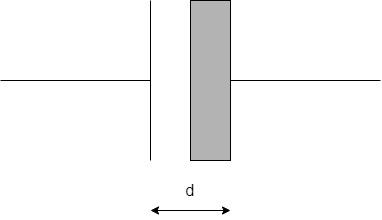Question
Question: A parallel plate air capacitor has a capacitance C. When it is half filled with a dielectric of diel...
A parallel plate air capacitor has a capacitance C. When it is half filled with a dielectric of dielectric constant 5, the percentage increase in the capacitance will be

A. 400%
B. 66.6%
C. 33.3%
D. 200%
Solution
Whenever the gap between a capacitor is filled with a dielectric material, the capacitance increases by a constant known as the dielectric constant of the medium. However, when it is half-filled, we have to consider the serial combination of the capacitance without the dielectric and with the dielectric.
Complete answer:
It is given that a parallel plate capacitor has a capacitance C. It is half filled with a dielectric of dielectric constant 5. We need to find the percentage increase in the capacitance.
That capacitance of a capacitor is given by equation
C=dε0A
Where, ε0 is the permittivity of free space, A is the area and d is the distance between the plates of the capacitor.
In the presence of a dielectric the equation for capacitance is given as
C=dε0kA
Where k is the dielectric constant.
The dielectric is only half filled as shown:
Thus, we can consider this as two capacitors connected in series, one having air as a dielectric medium and the other having the material with dielectric constant 5.
The initial capacitance is
C=dε0A
The dielectric constant of air is one. Since the distance between the capacitors is half-filled, the actual distance to be filled is, 2d.
After inserting dielectric, the capacitance of part having air is
⇒Ca=2dε0A
Since the area is only half the initial area.
⇒Ca=d2ε0A
The capacitance of the part with dielectric medium is
⇒Cd=2dε0kA
⇒Cd=d10ε0A
The net capacitance is the series combination of the capacitances Ca and Cd which is given by the formula –
C′1=Ca1+Cd1
⇒C′1=2ε0Ad+10ε0Ad
⇒C′1=10ε0A5d+d
⇒C′1=10ε0A6d
∴C′=6d10ε0A=3d5ε0A
This is the final capacitance.
Now let us calculate the percentage increase.
Percentage increase can be calculated as
ΔC = CC′−C×100
⇒ΔC = dε0A3d5ε0A−dε0A×100
⇒ΔC = dε0A3d5ε0A−3ε0A×100
⇒ΔC = dε0A3d2ε0A×100
⇒ΔC = 32×100=66⋅66%
Thus, the percentage increase in capacitance is 66.66 %.
So, the correct answer is option B.
Note:
If the dielectric material is filled in the entire distance but only, half the area of the plates, we have to consider it as a parallel combination. The net capacitance in the parallel combination is equal to the algebraic sum of the individual capacitances.
